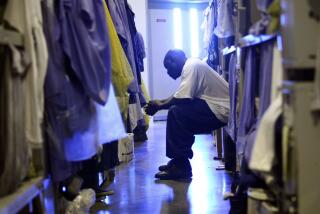Shut the Criminals’ Revolving Door
- Share via
During the past 25 years, much of the crime debate has been dominated by criminologists who are philosophically opposed to punishment. In an attempt to advance their agenda, they have perpetrated a wide array of myths. The recently released report of the bipartisan Council on Crime in America is an attempt to provide an alternative: a rigorous, empirical, real-world analysis of the current state of crime and punishment.
The report tells us that the nation faces at least three distinct but related crime challenges: preventing at-risk children from becoming criminals, protecting innocent people from becoming crime victims and restraining convicted criminals who are under the “supervision” of the criminal justice system (on probation, parole or pretrial release) from committing additional crimes.
Prevention. We know that children born into poor families--no matter their race, region, religion, demographic stripe or socioeconomic status--if they have decent families and grow up with responsible, caring adults in their lives, are far less likely to become either victims or victimizers. We also know that not all children are born so lucky.
America is now home to nearly 70 million children 18 or under. As many as 15 million of them are growing up in relative poverty, often in places where the institutions of civil society--families, churches, schools, voluntary associations--are in near-complete collapse. The report argues that neither more spending by government nor the mere withdrawal of government can prevent today’s at-risk 4- to 7-year-old boys from becoming the next decade’s 14- to 17-year-old predatory street felons or the next century’s first big class of adult career criminals. The key to prevention is moral education. That, in turn, depends on reviving the character-forming institutions of civil society. But we know that there is no easy way to accomplish that.
Protection. The recent widely reported drops in serious crime in New York, Houston and other cities were due largely to innovative community policing strategies, citizen anticrime initiatives and continued “target-hardening” or increased security and personal safety measures by individuals and businesses. But these drops in crime may be merely a lull. The storm is gathering in the form of a demographic bulge of highly crime-prone boys. During the next 10 years, enormous upward pressure will be exerted on crime rates. Redoubling crime protection efforts will not keep the storm offshore. But it can help to minimize the damage and reduce the human and financial cost.
Restraint. The criminal justice system imprisons only one criminal per 100 violent crimes. Most violent prisoners serve less than half their time in prison before being released. In 1993, there were 43.6 million criminal victimizations in America, more than 10 million of them violent. Between 1985 and 1993, the rate at which boys 14 through 17 committed murder increased by about 50% for whites and 300% for blacks. A third of all violent crimes, including murders, are committed by felons out on probation, parole or pretrial release. What is involved here is more than a failure of public safety; it is a massive failure of governmental obligation. Citizens should not have to accept their government’s prolonged, persistent failure to restrain violent and repeat criminals. A government incapable of restraining known, violent, repeat criminals within its custody cannot be trusted to take on more complicated and costly public functions.
There is also the matter of eroding public trust in our political institutions. A government that, amid much fanfare, passes wave after wave of get-tough anti-crime laws but proves toothless in the execution of those laws eviscerates pubic confidence in the integrity of lawmakers and the criminal justice system. Indeed, in 1993 and again in 1994, there was only one public institution in which the American people had less confidence than in Congress: the criminal justice system. No representative democracy can long survive this deep and disheartening lack of public trust. And the only way to restore public trust is to shut the revolving door.
A final point: A society tells as much about itself by what it punishes as what it praises, by what it condemns as well as what it encourages, by what receives reprobation as what receives approbation. The message of our justice system is all too clear to criminals and victims: Too often, for too many, it says “nobody cares” and “nothing matters.” That has to change soon or the carnage and violence that have become almost permanent features of America’s landscape will worsen.
More to Read
Sign up for Essential California
The most important California stories and recommendations in your inbox every morning.
You may occasionally receive promotional content from the Los Angeles Times.













